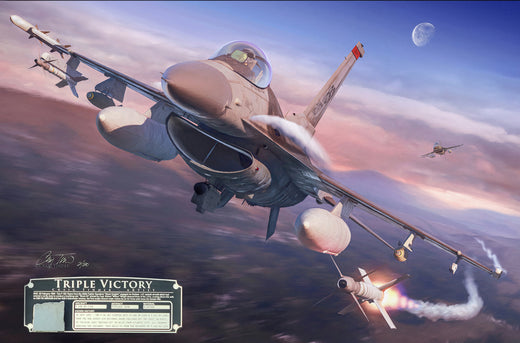This Fine Art Print by Artist Craig Tinder commemorates Retired Col. Robert "Wilbur" Wright and his actions on 28 February 1994.
This print was illustrated in conjunction with Col. Wright in order to ensure detail-level accuracy, all the way to the phase of the moon and snowy terrain depicted that fateful morning.
Details About the RELIC:
This relic comes from an avionics panel of F-16D 84-1320, an aircraft previously flown by the New Jersey Air National Guard. The aircraft was later released as surplus after being involved in a mid-air collision with another jet. Following the accident, the F-16D crashed into the ocean, resulting in the light corrosion visible on the panel. Fortunately, all crew members from both jets safely ejected and survived the incident.
 Avionic panel from F-16 Viper 84-1320
Avionic panel from F-16 Viper 84-1320
 Underside of relic from F-16 Viper 84-1320
Underside of relic from F-16 Viper 84-1320
The Story Behind the Print:
28 February 1994, two F-16C Vipers from the 526th Fighter Squadron, known as the "Black Knights," were conducting patrols in support of NATO's no-fly zone over Bosnia when they encountered an aggressive violation by Serbian forces. Six J-21 Jastreb aircraft had entered the restricted airspace to carry out a bombing raid, breaching the zone and threatening stability in the region. The Vipers, led by Capt. Robert "Wilbur" Wright in "Black 03," quickly moved to intercept the intruding aircraft in what would become a historic air-to-air engagement.
 "Triple Victory" framed canvas alongside many F-16 artifacts
"Triple Victory" framed canvas alongside many F-16 artifacts
Capt. Wright, an experienced fighter pilot, locked onto the first J-21 using the advanced AIM-120 AMRAAM (Advanced Medium-Range Air-to-Air Missile), firing with deadly precision. The missile struck its target, taking down the Serbian aircraft in a matter of seconds. Wasting no time, Wright then turned his attention to the remaining J-21s, launching two AIM-9 Sidewinder missiles in quick succession. Both missiles found their marks, resulting in the downing of two more Jastrebs. In the span of a few minutes, Capt. Wright had achieved what hadn’t been done by a U.S. Air Force pilot since the Korean War—a triple kill in a single mission.
This encounter marked the first time a U.S. pilot had scored three air-to-air victories in a single mission since the days of propeller-driven aircraft over Korea. Capt. Wright’s success with both the AIM-120 AMRAAM and AIM-9 Sidewinders underscored the technological superiority of the F-16 and the skill of its pilots in modern combat scenarios. His actions not only enforced the no-fly zone but also demonstrated the effectiveness of NATO's air power in controlling the skies over the conflict-ridden Balkans.
Artist Craig Tinder sought to authentically capture the historic moment of Capt. Robert Wright's triple victory by interviewing the pilot himself. Through detailed conversations, Tinder recreated the precise conditions of the engagement based on Capt. Wright’s recollections and the footage from his heads-up-display video. The painting incorporates elements such as the phase of the moon, the snow-covered terrain below, and the soft morning light that filtered through the sky on that pivotal day. By meticulously blending these details, Tinder’s artwork offers a vivid and historically accurate representation of the air battle, allowing viewers to experience the intensity and precision of Capt. Wright’s actions as if they were there themselves.
Learn more about the The F-16’s Worldwide Dance of the Global Viper. Click Here
To purchase or see similar items, visit here.
Commissioned by Museums, Treasured by Collectors





Share:
Restoring History, the story behind "Old Glory"
Homeward Bound with Shady Lady